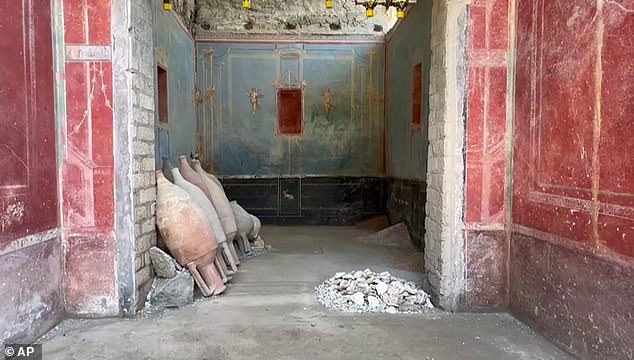Archaeologists digging through the ashes covering the ancient city of Pompeii have discovered a room painted in a color rarely seen among the ruins.
The walls of the space were a stunning bright blue with frescoes of female figures representing the four seasons along with images of agriculture and herding.
The team suggested that the room was used for pagan rituals and for the storage of sacred objects, since the color blue has only been found in places of great importance.
The work is part of an excavation project that has discovered 13,000 rooms in 1,070 houses that were in the Italian city before being buried under volcanic ash by Mount Vesuvius in the year 79 AD.
Archaeologists digging through the ashes that covered the ancient city of Pompeii have discovered a blue-painted room, rarely seen among the ruins.

The discovery was made while archaeologists were excavating the second floor of a housing unit, uncovering a tunnel leading to the rare blue room, called Room 32.
Pompeii, which lies 14 miles southeast of Naples, was once a bustling city with about 15,000 residents before the eruption destroyed it on August 24, 79 AD.
The natural disaster is believed to have killed 16,000 people in Pompeii and surrounding cities, making it one of the most destructive volcanic eruptions in history.
The remains of the city were first discovered in 1748, and archaeologists are still discovering more about the lives of those who once called Pompeii home.
Italian Culture Minister Gennaro Sangiuliano visited the site on Tuesday and described the ancient city as “a treasure chest that is still partially unexplored.”
The latest discovery was made while archaeologists were excavating the second floor of a housing unit, uncovering a tunnel leading to the rare blue room, called Room 32.
The space was accessed through a hallway that led to a garden that was once filled with beautiful fruit trees and vines, according to a translated version of the study.
The study also noted that rooms like this were “intended for private religious rites.”
Each of the four women depicted on the walls has something in one hand and is adorned with a crown of flowers.
Some wear loose dresses, while others go without clothes.
The blue walls were also found to have stunning gold details, showing hand-painted pavilions and designs preserved for thousands of years.

The walls of the space were a stunning bright blue with frescoes of female figures representing the four seasons.

Images representing agriculture and animal herding were also found on the walls.

Investigators discovered 15 jugs, still leaning against the wall, oil lamps abandoned in the area and three decorative boxes located within the walls that likely contained devotional statues.
Investigators discovered 15 jugs, still leaning against the wall, oil lamps and three decorative boxes located within the walls that likely contained devotional statues.
Building materials were also found, such as piles of oyster shells that were probably mixed with plaster and mortar.
The findings suggested that the house was being renovated before being buried by volcanic ash.
However, the room was previously accessed in the 17th and 18th centuries by people who probably stole the statues that were once in the boxes on the wall.

The study noted that these rooms were “destined for private religious rites.”

The blue walls also feature stunning gold details, showing hand-painted pavilions and designs preserved for thousands of years.
The only written account of what happened at Pompeii came from a poet named Pliny the Younger, who watched the disaster unfold from a distance.
His letters describing the horrific event were found in the 16th century and reveal that the avalanche of hot ash took residents by surprise.
Plinio said that a column of smoke “like a stone pine” rose from the volcano and caused the cities around it to become as black as night.
Although the eruption lasted about 24 hours, at midnight the first pyroclastic waves began, causing the collapse of the volcano’s column.
An avalanche of hot ash, rock and poisonous gases rushed down the volcano’s side at 200 kilometers per hour, burying victims and the remains of daily life.
Hundreds of refugees sheltering in the vaulted arches on the seashore at Herculaneum, clutching their jewels and money, died instantly.


